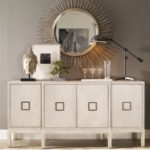Recently, we posted a blog titled “Dining Room Design Rules” to give more specific direction for the DIY’ers out there on how to better style their eating space. Among other things, we wrote on table placement and size, lighting and dining room rugs; but, what we didn’t mention was anything about the use of buffets, console tables and sideboards (the names of these can be interchangeable) in the room design. More often than not, a dining room design can feel incomplete without featuring one of these pieces. Read on for rules and simple design tricks on how to incorporate buffets or sideboards into your current dining room style.
First and foremost, be aware of size. Work within your dining room limits and don’t try to over extend the space. If your space is on the smaller side, along with your table, aim to find a two door or smaller console table or wine rack that can be strategically placed in a corner. If working with a larger space, adopt a bigger buffet for the middle of a wall to balance out the area. Work in perspective – don’t have a large table and a small buffet. Aim to keep the sizes proportionate as it allows for the room to have better spatial flow and symmetry.
While buffets and consoles really are considered “accent pieces,” expand beyond the category rule and utilize them. Buffets are also meant to be used to serve food on, store precious dishes and linens and to keep dining necessities close. Same with wine racks and sideboards. Keep the overflow of the kitchen hidden away in the dining room.
Specifically, look for a buffet that’s 36 to 42 inches high and just deep enough to hold a serving platter. Anything outside of these height dimensions will feel awkward next to an average dining table. And, if not deep enough to even hold a platter to serve food on when hosting guests, would just be a waste of space.
Oftentimes this will be the only space in the dining room that can be accessorized (as it is not used daily as compared to the dining table itself), so play up your personal style and accessorize the table. Work with a variety of elements to create a balanced feel but more importantly choose items that speak to you and don’t clash with the overall room design. When accessorizing, keep these tips in mind:
 Work vertically and create a design up the wall to fill the empty space above the table. Choose to incorporate a vase with flowers or tall candlesticks off to one side of the console for dramatic height. Or, place a tiered fruit rack off to one side. A tried and true trick to create vertical space is to also rest a mirror on the table. This accent piece will help draw the eye up.
Work vertically and create a design up the wall to fill the empty space above the table. Choose to incorporate a vase with flowers or tall candlesticks off to one side of the console for dramatic height. Or, place a tiered fruit rack off to one side. A tried and true trick to create vertical space is to also rest a mirror on the table. This accent piece will help draw the eye up.
Make use of the entire table top. The table accent pieces should be placed out horizontally, but don’t overcrowd the space. Use a decorative bowl or an oval platter to elongate the table top from the center out. Strategically place a runner extending from one end to the other and also add in other small squat accessories to the table top decoration. Some of the favorite designs we have seen are the use of short tumbler glasses next to bottles of vintage liqueurs for a horizontal affect.
Add one or two lamps (on each side) to create a more intimate mood rather than relying on the overhead lights for dinner conversation. This is where candles also come into play on the buffet top.
Accessorize with art and personal touches. Hang an eye-catching piece just above the table or simply rest it against the wall in the center of the space and work your way out. Incorporate varying sizes of framed photos or artwork for a more visually dynamic image.
With every design, the trick to remember is to fill the table – not to overcrowd it. Keep your accessories simple and neutral if there are other loud elements in the room. And remember that if inspired by your own personality, the buffet will be another place in the house where your style is showcased.
Photos courtesy of Vanguard Furniture